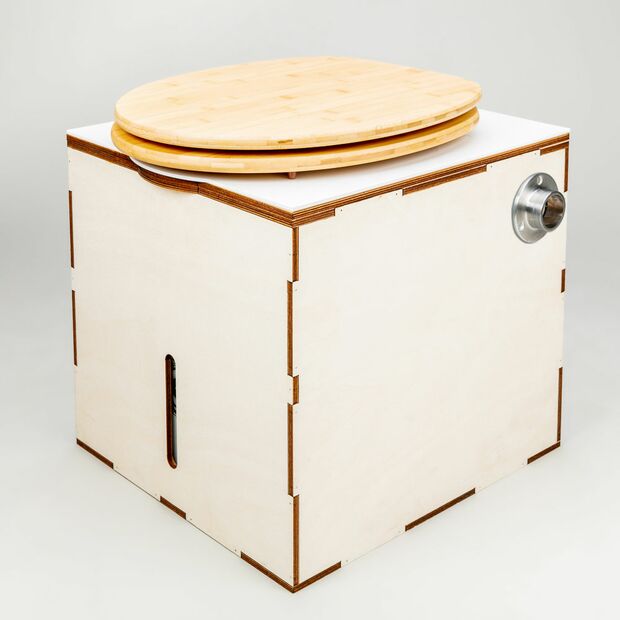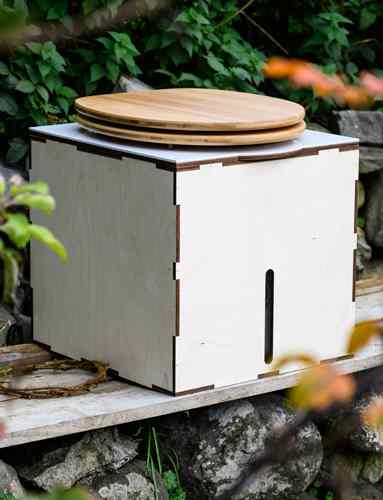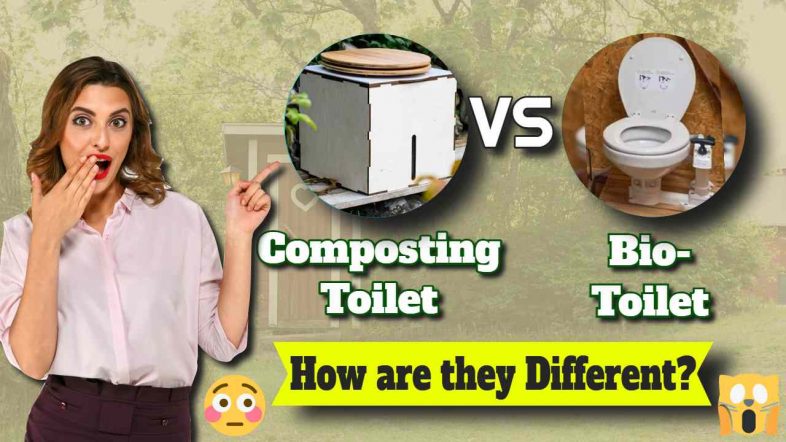The question of what is a composting toilet and how is it different from a biogas toilet (Bio-toilet) has been asked of us several times recently.
It's the composting toilet vs bio-toilet debate, that arises from an article we wrote almost 2 years ago in which we described a biogas “bio-toilet”.
That's an eco-toilet which has a flushing system to wash the output to a home anaerobic digestion plant. In that article, we referred to a bio-toilet plumbed to a HomeBiogas home digester.
On This Page
- The Composting Toilet as Defined by Wikipedia
- What is Bio-toilet? Is a Bio-toilet a “Biological Toilet” or More Specifically a “Biogas Toilet”
- The Essential Difference Between “Composting” Versus “Anaerobic Digestion”
- Composting Toilets Increasingly Used for Homes-on-the-Move and Small Homes
- Composting Toilet Suppliers
- An Explanation of Compost Toilets and Future Toilet Tech!
- Do Composting Toilets Need Added Chemicals or Materials in Order to Work?
- Wet and Dry Composting Toilets
- What to Consider When Choosing the Best Composting Toilet
- AC/DC Composting Toilets
- Self-contained composting Toilets
- Dry Composting Toilet with Crank Handle
- How do Composting Toilets Work?
- Are Composting Toilets Legal in the US?
- The DIY Composting Toilets
- How do you install and Use a Composting Toilet?
- Is a Composting Toilet Comfortable?
- Do You Put Toilet Paper in a Composting Toilet?
- Can You Poo in a Composting Toilet?
- How Long Does a Composting Toilet Take to Work?
- Where Should I Empty a Composting Toilet?
- How Much Do Waterless Compost Toilets Cost?
- What is a Composting Toilet? And, Bio-Toilets – A Conclusion
In that article, we discussed a specific idea of a bio-toilet and only subsequently did it occur to us that our definition may differ from the way some others use the term. The difference, of course, lies in the difference between “composting” and “digestion” (as in “anaerobic digestion”) so there was nothing for it other than to go on to write this article to clarify.
But, before we start the article we suggest that you watch our video below. That way you will understand exactly what we mean by a composting toilet:

The Composting Toilet as Defined by Wikipedia
In many composting toilet designs, a carbon additive such as sawdust, coconut coir, or peat moss is added after each use. This practice creates air pockets in the human waste to promote aerobic decomposition. This also improves the carbon-to-nitrogen ratio and reduces potential odour.
Most composting toilet systems rely on mesophilic composting. Longer retention time in the composting chamber also facilitates pathogen die-off. The end product can also be moved to a secondary system – usually another composting step – to allow more time for mesophilic composting to further reduce pathogens*. via Wikipedia.
* Pathogens are organisms that cause disease.
This definition is consistent with other forms of composting (for example garden composting, household waste composting etc., and it clearly establishes that composting is confined to “aerobic decomposition”, leaving all oxygen-depleted and oxygen-starved decomposition in the realm of “digestion” in “anaerobic digesters”.
This leads us to consider the bio-toilet as an anaerobic device, versus composting toilets being in principle aerobic, even if at a microscopic scale in the composting particles some anaerobic activity does occur:
What is Bio-toilet? Is a Bio-toilet a “Biological Toilet” or More Specifically a “Biogas Toilet”
A bio-toilet isn't just a “biological toilet” it is specifically a toilet that is designed to use the anaerobic digestion process, which occurs only in anaerobic conditions where air/ oxygen is absent.
There was no definition of a bio-toilet on Wikipedia when we wrote this article so, we would venture to suggest that a bio-toilet:
“is a type of toilet which disintegrates and decomposes human-waste into water and biogas. The decomposition is carried out by bacteria in the absence of oxygen in what is known as the bio-digester or digester tank.”
 Both bio-toilets and composting toilets:
Both bio-toilets and composting toilets:
- are environment-friendly when emptied correctly,
- reduce sewage production and related sewage treatment problems and also
- only need a much-reduced water consumption.
That's because the standard flushing toilets we use throughout the developed world require 3 to 6 litres of flushing water per use, but for bio-toilets, the amount needed can be as low as 0.5 to 1.0 litres.
The Essential Difference Between “Composting” Versus “Anaerobic Digestion”
Many writers on the subject of composting versus anaerobic digestion, don't seem to have fully appreciated the simple aerobic to anaerobic distinction. It is all about whether or not air (oxygen) is present during the process.
Jagran Josh at www.jagranjosh.com agrees with us (albeit in quite elaborate language) that decomposition occurs in a “digester tank”. But after that, we are certain Jagran's definition is wrong, as it fails to appreciate that a digester is an anaerobic device, and not aerobic.
Aerobic systems cannot produce methane, the microbes which produce methane are either anaerobes or facultative anaerobes (which can survive to make methane but only when small amounts of oxygen are present in oxygen-depleted/ anaerobic environments). Here are Jagran's words:
“Bio toilet” is a decomposition mechanized toilet system which decomposes human excretory waste in the digester tank using specific high graded bacteria (
aerobic oranaerobic) further converting it into methane gas and water. Bio toilet is a different toilet as compared to the traditional restrooms.”
We have struck through the word “aerobic” which makes no sense here to us. Composting toilets do not produce biogas and don't provide much-needed renewable energy. But they do have environmental advantages and they can be used dry, with no water needed at all.
For more information on bio-toilet design, how they work, and where these can be bought go to our bio-toilet article here, otherwise continue to read on.
For the remainder of this article, we have moved away from considerations of anaerobic digestion and biogas, to discuss composting toilets in more detail.
Composting Toilets Increasingly Used for Homes-on-the-Move and Small Homes

If your mobile home, RV, or tiny house lacks the plumbing to support a traditional flushing commode, a composting toilet may be the solution.
This is the once-unusual kind of toilet, which is increasingly finding favour with environmentally aware people. Those of us seeking to do our bit to reduce the carbon emissions causing climate change are taking up the idea in increasing numbers. It is recognised that composting toilets which use aerobic bacteria to break down human waste can:
- Stow their charge in a neat, easy-to-remove package using very little space.
- Need not produce any odour problems.
- Are also low in cost to maintain.
- Can be emptied at many composting locations without needing a foul sewer access point.
Composting Toilet Suppliers
There is a rising number of companies that make self-contained composting toilets. Kildwick is a good example and a well-known popular toilet brand. Sun-mar is another with a wide range and yet another example is Nature’s Head. They all sell toilets suitable for home use and to be used on the move. Their most popular use is:
- in a tiny home or cabin where there is no space for a traditional flushing toilet, and
- where there is no mains sewer available to accept the discharge of flushing toilets.
Composting toilets are almost without exception designed to fit in small spaces such as tiny homes, RVs, cabins, and a lot more. If you have any experience with the brands mentioned, you will appreciate how a composting toilet does not take as much room as a regular one.
For the resourceful and environmentally aware, Kildwick even sells DIY versions.
An Explanation of Compost Toilets and Future Toilet Tech!
A compost toilet is a waterless toilet that utilizes natural decomposition and evaporation processes to get rid of human waste. These types of toilets are common at campgrounds and off-grid homes and cabins which don’t have access to running water.
Composting toilets and methane-gas-producing bio-toilets are an exciting new development, especially for back-to-nature types.
However, they are not the only new toilet designs coming up. We understand that there are several new toilet designs that are being funded for development and one already in production is:
- a microwave toilet that transforms waste into energy. The idea is funded by Bill Gates the original Microsoft founder.
Do Composting Toilets Need Added Chemicals or Materials in Order to Work?
This is a question that we get asked more often than we thought we would and the answer is pretty simple. So let’s get straight into it.
All composting toilets require some media to mix with the solid waste. You can use many media types, including:
- peat moss,
- coconut fibres,
- sawdust,
- woodchips,
- shredded leaves, and
- there are plenty of others you can use subject to their availability.
Sawdust is the most popular, it is readily available and is inexpensive. It also works very well.
Compost toilets can be divided based on several different criteria with and without separate liquid/ urine compartments and collection. However, we believe it's easiest to think of the different types of toilets by first looking at how they process the waste, and then considering how they are built.
Wet and Dry Composting Toilets
Composting toilets are causing a lot of interest in the world of eco-living, in the last few years as thoughts turn to where societies all around the world can get the ever-rising volumes of water demanded to supply more and more flushing toilets.
From the waterless models to the dry flush systems and the low flow types, you are spoilt for choice.
There are fundamentally only two types of composting toilets: wet and dry.
The most common modern types of composting toilets are:
- dry and
- feature a tray or compartment for the liquid collected, that can be pulled out and emptied.
Usually, there’s not much need to empty them as much of the waste turns quite quickly to compost (especially in warm conditions), so you may be able to put it straight into your garden or another compost pile.
Two types of toilet kits are sold, these being:
- a self-contained kit with the composting unit being the lower part of the toilet and
- another model where this unit is separate.
Some models are fitted with a fan to remove the biogas or any foul odour emanating from the waste.
Some suppliers go beyond the toilet and will supply a separate garden or backyard composting unit for use in conjunction with their composting toilet. The purpose of all the designs is to take the output from the composting toilet and use microorganisms to decompose human waste by mixing it with wood shavings, lawn clippings and other organic matter;
- that provide efficient contact with air, and
- at an optimum temperature and moisture content,
it turns into compost suitable for release to the environment as humous within weeks.
What to Consider When Choosing the Best Composting Toilet

Now that we know what both incinerating toilets and composting toilets are, let’s talk about the main differences that you need to consider before choosing either of the two. There are seven major differences to consider, so let’s take a look.
Now, we’re down to the things to consider when finding the best toilet for off-grid living, camping, recreational vehicle living or marine applications. Let’s discuss them and later be able to compare what you have to weigh when choosing the right composting toilet for your needs and situation.
Finding the right RV caravan composting toilet requires knowing what features make up these devices. Read through the manufacturer's instructions and let them guide you through their essential parts and be sure to make a smart, responsible decision.
Look for:
- Separate urine collection
- Overall durability: durability is one of the most important factors when choosing an RV composting toilet
- Choice of sustainable materials in manufacture: the use of plastic in products is to be avoided (wherever possible), due to the need to reduce plastic use and lower the accumulation of plastics in our oceans.
AC/DC Composting Toilets
Most composting toilets work by evaporating liquid and controlling solid waste decomposition. This works best when urine and solid waste stay separate.
“I did a lot of research when looking for a composting toilet for the new rental house I was building on my property. I decided upon the Separett 9200 villa that separates liquid waste from solid waste. It seemed to make sense that separating the solids from the liquids would increase the decomposition rate of the solid waste, keeping it drier as well, which in turn would decrease any unpleasant odours indoors.”
The Separett Villa 9215 is an updated version of the company’s celebrated villa line of composting toilets. It’s designed to replicate the appearance and experience of a traditional flush toilet as much as possible. Unlike many other composting toilets, the villa looks a lot like a traditional toilet.
The Separett Villa is a composting toilet which was just introduced in 2018. This means that it is using some of the most current composting toilet technology.
Self Self-contained Composting Toilets
A composting toilet can be an option as a portable toilet in the right situations. Composting toilets are rather large to be considered a portable toilet, however, they can be used in a variety of situations where you need to have a toilet and regular plumbing is not an option.
The “Nature’s Head” composting toilet is a very self-contained, compact toilet. Although small enough to be housed in a small space, it still has a comfortably-sized seat. It uses no water to operate and has a urine separator (which typically needs emptying about every two days). The design, in common with many others, is such that it easily disassembles for emptying and has a full-size seat. They are described as extremely comfortable and easy to use.
Other names which supply similar “earth tech” toilet units are Kildwick, Greenlatrine, and Separett.
“Biolet” is a composting toilet brand which describes its product range as “uniting the natural composting process with advanced technology”. The purpose of their “technology” is to accelerate and optimize biological decomposition, evaporating excess liquid and venting odours.
This description would at first glance seem to be nothing but the use of some flowery language! However, their units are supplied as part of a bathroom fixture that is described as being easy to use and economical to operate. They do apply high technology to the very basic and natural composting process.
“Closed-system Biolet toilets are fully automatic electric toilets that anticipate your movements”,
their website says. Read on and you discover that:
“Sitting on the toilet seat opens the trap doors, and closing the toilet seat lid activates the stainless steel mixing mechanism that efficiently breaks down paper and distributes moisture into the compost material in the upper chamber.”
Other designs use a rather less “high technology” solution with, we presume, a similar beneficial effect, as described in the following paragraph:
Dry Composting Toilet with Crank Handle
Indoor waterless toilets for homes need to run on an efficient composting system to avoid odours and pests.
Turning the composting material has long been known to improve the composting material as it ensures the micro-organisms are evenly spread through the biomass and allows air into the small spaces within the material.
The choice of a dry composting toilet with a crank handle is a good one. This is so because the turning should make the composting process faster. This means the easier it will for the user to empty the composting chamber to allow for fresh waste.
How do Composting Toilets Work?
The composting process on these toilets works on a very simple theory. The waste material is allowed to decompose in the same way as the garden waste decomposes in the garden composter. The difference is mainly what content is being composted.
Composting toilets are described as “getting the job done”. They are most often used when:
- living in a tiny bijou house, or glamping,
- off-grid on a boat or cabin,
- to reduce the current climate change emergency as they are much more sustainable than old water-flushing traditional toilets which use so much more precious drinking water.
They don’t require hookup to a sewer system, as they work by letting the natural process of aerobic decomposition occur.
When a homeowner is considering purchasing a composting toilet system, one of the first and most important questions they must answer is whether the system will comply with their local building codes and regulations. This can be a tricky topic because building codes vary widely from country to country, and even within countries.
Are Composting Toilets Legal in the US?
In general, this question mainly applies to people wanting to build a new home with a permit for a composting toilet instead of a sewer or septic system, or in public places.
Composting toilets do not use water in the process. Rather, they work by using natural decomposition and evaporation to recycle human waste. Installing a composting toilet in a rural area or in the mountains is fairly common, and may not be regulated.
No state or federal law is known by the author to disallow composting toilets outright, but some states may require installation by licensed professionals only. However, there are individual municipalities that prohibit any backyard composting. If your council includes necessary processing from composting toilets in the prohibited list, in those municipalities, composting toilets are not legal.
So, you should check your local sanitary and planning regulations before putting composting toilets into a home in a town or city home. There may be local regulations for “habitable properties” that require homes to have flush toilets and connections to sewer systems.
DIY Composting Toilets
DIY composting toilets are available. They come complete, delivered to you on a pallet, ready to unload and use.
Such composting toilets tend to include as standard:
- a timber cubicle made from quality timber, treated with a preservative to the exterior
- urine-separating toilet seat built into a timber-framed box
- the pipework is already installed for the liquid waste and collection container.
How do you install and Use a Composting Toilet?
Composting toilets are easy to install and simple to use. So, how do you install them with low maintenance needs and a guaranteed odour-free operation?
There were recently still no US, or widely used national or international, regulations for quality control standards of manufactured composting toilets. However, most manufacturers are voluntarily meeting the same standards that wet toilets must meet.
In the US that's the ANSI/NSF International Standard 41, updated in 2009 to accommodate for new reduced-water toilet styles.
Despite the initial hesitation, there are many testimonials online which suggest that those who do install a composting toilet soon discover that this alternative form of disposing of waste is very effective and easy to use. However, one or more people in every household will need to keep an eye on their composting eco-loo at all times and empty it at the right time.
We also do note that correctly designed and operated waterless and composting toilets do seem to be reported by users as actually smelling less than conventional toilets in use. Even without the use of the fans so often installed in traditional toilets. This means higher reliability and no electricity required for installation.
But, responsible disposal is essential, and the companies which sell these products probably should do much more to point out that:
- unlike flushing toilets which once flushed require no more attention to dispose of the wee and poo
- composting toilets HAVE to be emptied correctly and if they are not
- a serious public health danger is likely to occur.
Is a Composting Toilet Comfortable?
A modern and high-quality compost toilet is very efficient and comfortable, therefore, not comparable to the old toilet from my grandmother's time. It is time to put an end to that unfair prejudice.
I’ve had all sorts of reactions to my toilet. Some blink and turn away, others glance furtively at it the way you might glance at a road accident before you catch yourself. Children, in particular, show a disturbing fascination in what lies beyond ‘the hole'.
But, the fact is that once used, concerns are unfounded and these toilets cease to be seen as anything unpleasant or indeed remarkable.
Do You Put Toilet Paper in a Composting Toilet?
Yes.
Can You Poo in a Composting Toilet?
This one had to be answered, even if we are a bit tired of hearing about poo and poop. Yes, of course, you can!
Rather surprisingly we are told that even including poo, the waste entering all toilets is over 90% water. In a “dry toilet” the water is evaporated and carried back to the atmosphere through the vent system.
The urine diversion system carries sterile urine to storage containers to be diluted and used as fertilizer or discharged directly into the ground via a shallow soak pit.
How Long Does a Composting Toilet Take to Work?
These toilets use cold composting, which relies on good air circulation rather than heat to break down the manure and kill off pathogens. It takes anything between 1 month and 3 months – possibly longer for full composting to be completed. It depends on temperature, water content, the fibrous materials added, the mix of different organisms present, and many more factors.
But, no designs require this. This question has no bearing on how easy these toilets are to use. Composting toilets are emptied as soon as they are filled.
Where Should I Empty a Composting Toilet?
Even the best composting toilet or “Eco-Loo”, requires a more hands-on approach to managing human waste than the “flush it and forget it” system traditionally used. And, to ignore a composting toilet if something goes wrong with the system such as urine getting into the poo, would not be a particularly pleasant task.
Emptying loo compost bins is quite safe to do if the compost has been stored for more than nine months. The chances of a pathogen still being alive by then are very low, and experts say that the risk is about the same as handling soil from the garden. But, clearly, very few people could wait that long!
Is it time to empty out your composting toilet and you’re not quite sure what to do with the pee and poop in there? There is conflicting information about where you can and can’t empty your toilet, and local regulations will vary.
Some composting toilet companies do give incorrect guidance on the liquid (“wee”) they suggest it can be poured into a composting heap or discharged directly into the ground via a shallow soak pit.
However, beware of doing this for any prolonged period in a garden or backyard. You may in certain geological soil types end up polluting groundwater and/ or local ditches and streams.
In general, they can be emptied into any well-run compost pile which will later be spread on land as humus/ soil improving and fertilising compost. But, this may be permissible as long as the liquid will be soaked up into the existing compost, where it will remain to decompose harmlessly, and will not run out or be washed out in heavy rain. The main problem here is for mixed faeces and urine.
The disposal problems associated with, say, chemical toilets are eliminated by having a UDDT. You’ll be surprised how easy it is to maintain a urine-diverting dry toilet. In fact, there are just two substances to be taken care of:
- Urine
- Faeces with cover material (and toilet paper).
Since they’re both completely natural, disposal is very simple! The urine can be poured out of the canister down any toilet – at a petrol station or motorway services, or even at home. Alternatively, it can be diluted and then used in your garden as liquid fertilizer.*
Your solids container should be lined with a bag to hygienically collect the excrement and the cover material. Once the bag isn’t quite full and you want to empty it, seal it tightly and throw it away with your normal household rubbish (which in Germany means the grey bin). via Kildwick's “Urine-diverting dry toilet article?” here.
How Much Do Waterless Compost Toilets Cost?
Like most products, you can get all-singing, all-dancing versions of compostable toilets that cost up to £2000-£4000. If you don’t mind spending this sort of money on a toilet, you can purchase a composting toilet that will do all of the work for you. There are two different types – a self-contained toilet and a remote toilet.

Simpler but perfectly useable versions are available for £200-£500 (say $250 to $650), with many models somewhere in between the two prices.
Composting toilets aren't just being installed for homes on the move anymore. Nowadays, many water consumers are using them in their homes to save on their water bills. That's where the homeowner has a water meter and because compost toilets use no water.
Flushing loos use a lot of water. By comparison, composting toilets will dramatically cut your water bill.
But, before you go for a dry toilet option in your home you must decide where the composting of the material removed from the toilet will be done, or will disposal be to your non-recyclable “mixed-waste” (black bag/ grey bag etc. council bin collection.
As we stated previously the solids from a urine-diverting dry toilet (UDDT) there is seldom a problem. It will usually be bagged and placed in a bin with your non-recyclable waste (wheelie bin) with the liquid flushed down a standard toilet.
However, in some nations such as announced in Scotland recently, that may not in future be permissible as nations bring in bans in principle on the disposal of all organic material to landfills via household waste collections.
But, if your composting toilet produces an output with urine mixed in, and you wish to do the composting yourself you must factor in the cost of doing that in a good neighbourly manner. And, doing it consistently in accordance with local regulations, and without causing groundwater or surface water pollution in your local geological conditions.
What is a Composting Toilet? And, Bio-Toilets – A Conclusion
For starters, composting toilets are toilets that use the process of natural aerobic decomposition to process waste. And that includes waste in both liquid and solid form.
There are a lot of designs for these off-grid toilets on the market and they are increasing in popularity. They appeal to those people who are aware of the need for us all to act in ways that both preserve nature and reduce our output of carbon emissions. If we fail it is pretty certain that life on earth will become very harsh and hard for future generations.
While aerobic processes are not as good for reducing carbon emissions as biogas-producing anaerobic technologies, they do meet many requirements for reduced water use etc.
Most people in Western society would be surprised to find out that there are a variety of composting toilets on the mainstream market. We are pretty sure most people have never even heard of composting toilets, however, that is changing.
Although composting toilets can save on water use and reduce water bills, they aren’t cheap when you include the need for a well-run composting pile to discharge the contents into.
The need for human care and attention to detail in running a home 365 days a year with a composting toilet is a lot more complex and needs more sophistication compared to a traditional flushing toilet. However, composting toilets are a great option for any home on the move, when in any event, holidaymakers will be away from their normal access and need to take special care of their detritus come what may.
When you factor in the cost of the necessary composting toilet's (and also bio-toilet) management time they become really quite expensive.
However, when done well, composting toilets will have a role much larger than in previous times, especially for all homes on the move and we encourage all our readers to consider their adoption or their alternative (bio-toilets).
So, now after a long and we hope comprehensive article we hope that we have answered the question to answer that was “What is a Composting Toilet”, and also equally we hope you can now answer the query “What is a Biogas Toilet (Bio-toilet)”. But for those that still have questions we have added the following FAQ section!
FAQs on Bio-Toilets and Composting Toilets
What is a composting toilet?
A composting toilet is a type of dry toilet that treats human waste by a biological process called composting. This process leads to the decomposition of organic matter and turns human waste into compost-like material, but does not destroy all pathogens.
How does a composting toilet differ from a bio-toilet?
A composting toilet relies on aerobic decomposition, which requires oxygen, to break down waste, while a bio-toilet uses anaerobic digestion, without oxygen, to decompose waste into water and biogas.
What environmental benefits do composting toilets and bio-toilets offer?
Both types of toilets are environment-friendly, reduce sewage production, create fewer related sewage treatment problems, and have much reduced water consumption compared to standard flushing toilets.
Can composting toilets produce any odour?
Most composting toilets are designed to minimize odour through the use of carbon additives like sawdust, which promote aerobic decomposition and help control smells.
Are composting toilets suitable for homes-on-the-move and small homes?
Yes, composting toilets are increasingly used in mobile homes, RVs, or tiny houses due to their compact size and the lack of need for traditional plumbing and sewage systems.
Do composting toilets need added chemicals or materials to work?
Yes, composting toilets require a carbon additive after each use to create air pockets that promote aerobic decomposition and manage the carbon-to-nitrogen ratio.
What carbon additives can be used in a composting toilet?
Common additives include peat moss, coconut coir, sawdust, and wood chips. Sawdust is particularly popular due to its effectiveness and low cost.
Where can I empty a composting toilet?
Composting toilets can typically be emptied at designated composting locations or areas that allow for the safe disposal of compost material.
What is anaerobic digestion in the context of bio-toilets?
Anaerobic digestion is the process used in bio-toilets where bacteria decompose human waste in the absence of oxygen, producing biogas and water.
What is the essential difference between composting and anaerobic digestion?
The essential difference is the presence of oxygen; composting requires oxygen (aerobic), while anaerobic digestion occurs without it.
Can aerobic systems produce methane?
No, aerobic systems cannot produce methane as the microbes responsible for methane production are anaerobes or facultative anaerobes that thrive in oxygen-depleted environments.
What companies supply composting toilets?
Companies like Kildwick, Sun-mar, and Nature’s Head supply composting toilets that are suitable for home use and mobile living spaces.
Are there any new toilet technologies being developed?
Yes, there are several new toilet designs being funded for development, including a solar toilet that transforms waste into energy, which has been funded by Bill Gates.
For additional questions and in-depth information, readers are encouraged to refer to this article's main content.
[First posted 16 January 2021. FAQs added November 2023.]





Oh, the ever-enthralling battle between aerobic and anaerobic digestion! Who knew that the intricacies of toilet technology could mirror the complexities of a high school biology class? To flush or not to flush, that is the question…
and it seems composting toilets and bio-toilets are both raising their hands with eco-friendly answers.
While the article does a stellar job of breaking down the ‘digestive’ systems of these toilets, it also brings to light the confusion that ensues when writers don’t quite ‘appreciate the simple aerobic to anaerobic distinction.’
Also, let’s not forget to give a nod to the unassuming sawdust and peat moss – the unsung heroes in the war against odour. Ultimately, whether you’re Team Composting Toilet or Team Bio-toilet, it’s a win for the environment. But, let’s not get too bogged down in the details!
The crux, as I see it, is the presence or absence of air. In the good ol’ days, understanding your machine was key. Likewise, distinguishing between these toilets comes down to the simple matter of “aerobic” vs “anaerobic”. Some folks might get caught up in the intricacies, but it’s clear as day to me: one system loves air, the other does its business without.
Both systems have their merits, and both aim to tackle our environmental concerns. It’s reminiscent of the evolution of machinery – adapt, innovate, and build for the future, while respecting the past. Composting toilets and bio-toilets, in their ways, echo the ethos of the industrial age: efficiency, innovation, and making the most of available resources. Lovely bit of engineering, that!
I think composting toilets are a great idea!